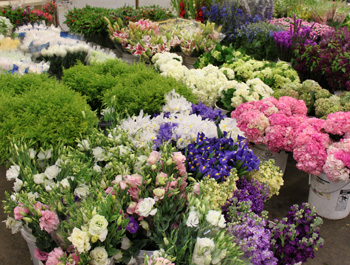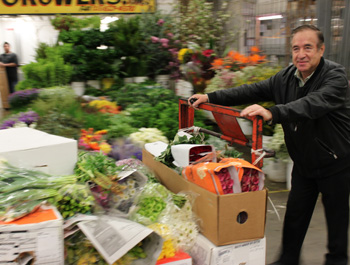 A little after midnight, a shipment of baby’s breath arrived at the Los Angeles Flower Market.
A little after midnight, a shipment of baby’s breath arrived at the Los Angeles Flower Market.
It was not an unusual occurrence. In fact, that shipment arrived at that time each week. But the employees who unloaded the hundreds of bushels from the unmarked truck parked conspicuously on a deserted Wall Street did so with a sense of urgency.
Hastily thrown on a rusted metal cart, the flowers were wheeled into the market. With blue painter’s buckets as vases, the baby’s breath was quickly arranged on the market’s floor.
The baby’s breath—along with the tulips, roses and hydrangeas that resided in its immediate area—would be arranged once more before the sun came up, and again later that morning when the public gained admittance to the market at 8 am.
Pat Dahlson watched the flowers come off the truck and complete their journey to the concrete floor. It had been a long journey. The baby’s breath came from Columbia, he suspected. The orders for his stand did at least.
Dahlson drank coffee out of a Styrofoam cup, and as the clock neared 3 am, he offered it generously.
“It’s late,” he agreed, shrugging his shoulders, a veteran who had seen many a night shift reach the morning light.
Thirty-two years ago, Dahlson’s parents opened a wholesale flower stand at the Los Angeles Flower Market.
The Los Angeles Flower Market and the Southern California Flower Market house about 200 vendors within the two blocks now referred to as the Flower District.
“I’ve been here everyday for those 32 years,” Dahlson joked.
Mayesh Wholesale Florists Inc. was a family business, and it was as a family business that it grew and expanded. The company now has 17 locations in seven states. It also now employs Dahlson and all of his eight siblings.
“It’s the beauty,” said Dahlson, now the CEO of the company. “The business gets to you. It grows in your blood.”
* * *
 Mayesh Whole Florists Inc. specializes in high-end flowers, which Dahlson aptly described as “stuff grown in different parts of the world.”
Mayesh Whole Florists Inc. specializes in high-end flowers, which Dahlson aptly described as “stuff grown in different parts of the world.”
While Dahlson claims the niche for exotic flowers in the market, importing is not a unique concept in the Flower District.
The district welcomes flowers from six continents daily.
“The flower market is completely different,” said longtime florist Chik Furuta. “In the old days, you used to have a lot of growers of domestic flowers. Now, 70 to 85 percent of the flowers are import flowers.”
Furuta travels to the district twice a week from Fountain Valley, Calif. to save 30 percent on his flower purchases.
“The cost of doing business in the U.S. is high, so they save money by importing,” Furuta said.
But Dahlson said that importing allows wholesalers the opportunity to do more than simply offer the lowest price.
“Importing has allowed us to have products at times of year when they didn’t exist before,” said Dahlson. “In years past when we relied only on California, you wouldn’t see the expanse of variety that we have any day of the week now because we’re searching around the globe for the product.”
Despite the obvious benefits to increased importing, California proves a hospitable environment for floriculture. Once the cut flower supplier to the United States, the state’s warm weather and temperate climate have attracted flower growers for decades.
“The first generation of Japanese-Americans was mostly growers. Italians came over and grew flowers in this region. So, it’s historical in that people grew flowers just like they did at home,” Dahlson said.
Fausto Orellana immigrated to the United States from Ecuador. Forty-five years ago, he moved his family business—the rose business—into the Los Angeles Flower Market.
Orellana imports roses and lilies from Ecuador through family connections for his store called St. Germain Flowers.
“It’s family,” his son Dennis Orellana reasoned, as he removed a recent shipment of pink roses from their boxes. “If you can’t trust your family, who can you trust?”
In fact, the only thing about Orellana’s business that isn’t family oriented is the name.
“My wife had the idea because it’s the saint for French for fate.” Orellana said, laughing. “It’s not really a family name. It’s just a French saint.”
* * *
Lacey Carter perused the plants at The Greenery. Feeling their petals briefly, she quickly jotted down notes on the small pad in her hand.
Dressed casually in a sweatshirt and jeans with her blonde hair tied back, Carter was among the few florists in the market at 2:30 am.
Carter commutes to Los Angeles twice a week from Bakersfield to take advantage of what she called the Flower District’s “good quality for a lot cheaper.”
Because she needs to be back in Bakersfield by 6 am, trips in the wee hours of the morning are a part of her normal routine.
A badge member of the district, Carter can attend the market’s wholesale hours—Monday, Wednesday and Friday from 2 to 8 am. And she always does.
“If you come when it’s open to the public, it’s insanely busy,” said Carter, adding with a shudder, “I’ve come a couple of times, and I’ll never come again.”
Furuta also comes during wholesale hours—and sometimes, before—to get the first pick of the flowers.
“I don’t preorder flowers, so I come and pick out my flowers twice a week,” said Furuta. “I just look for freshness and quality.”
It was that pursuit of “freshness and quality” that transformed a very daytime business—flowers need sun to grow—into an operation run primarily at night.
Before refrigerated trucks increased the shelf life of cut flowers, local growers would grow and cut their flowers during the day and bring them to a central distribution center at night.
“That’s how they did it because of what they had available to them,” said Dahlson.
“But now it only makes sense to stay that way because if we didn’t do distribution to our customers at night, traffic in and out of downtown Los Angeles would be so bad that I don’t know how [customers] would get here.”
“And the hours have evolved,” Dahlson added. “When I first started working years ago, you would see dozens of customers right here going crazy. Today, they’re not going to come until five in the morning.”
* * *
 Dahlson pointed out his niece, as she bustled around the stand collecting flowers. She is a designer for Mayesh Wholesale Florists Inc., a third generation wholesale flower vendor.
Dahlson pointed out his niece, as she bustled around the stand collecting flowers. She is a designer for Mayesh Wholesale Florists Inc., a third generation wholesale flower vendor.
“We grew up in the business and that was the path we took,” he said.
But uncertainty remains as to whether their company will be around to employ a fourth generation.
Cut flowers and blooming plants, an estimated $8 billion industry, have been hit by the recession.
As extravagant events have began to be seen in poor taste, the need for large orders of flowers has dropped significantly. As have the purchase of single bouquets.
“Never before have flowers been viewed as “I can live without them,’” said Dahlson. “It’s a discretionary item so it took a hit.”
Dahlson hopes that the economy will turn around and with it, that people remember what makes flowers so important.
“They’re beautiful,” said Dahlson. “And if things are tough, you bring some flowers home, you put some flowers on the table, and it’s just a really nice way to brighten your day.”














